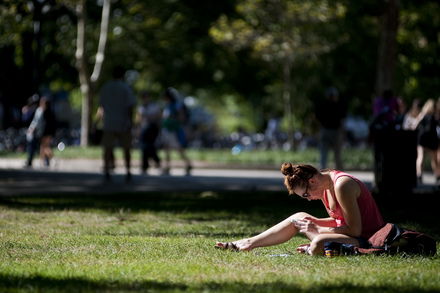University of Michigan shrinks freshman class but grows overall fall 2012 enrollment to 43,426

Students enjoy warm weather on the Diag at University of Michigan this fall.
Total enrollment at the university is 43,426, a 1.7 percent increase that marks the largest student body in university history.
Enrollment at U-M's Ann Arbor campus is among the largest in the country, although smaller than Michigan State University's enrollment.

University of Michigan President Mary Sue Coleman called a few admitted students in the spring, informing them of their acceptance.
During the previous two years U-M's freshman class was larger than desired —6,496 in 2010 and 6,251 in 2011— causing a housing crunch and leading to overfilled classes.
Earlier this year, admissions director Ted Spencer told AnnArbor.com he wanted to shrink size of the 2012 freshman class below 6,000.
"Our goal is to maintain fairly stable enrollment numbers overall," says Spencer. "This ensures that enrollment is scaled to resources."
From fall 2008 to fall 2012, U-M's freshman class size has grown nearly 7 percent. U-M reports a 97 percent freshmen retention rate, which is high amongst public schools.
Overall, there are 27,979 undergraduates and 15,447 graduate students.
There are more than 2,000 more men enrolled than women.
Underrepresented minorities make up 10 percent of the freshmen class, a 0.5 percent decrease from 2011 and a 0.6 percent decrease from 2010.
Overall, there are 2,207 blacks, 1,785 latinos, 442 Native Americans and 81 Hawaiians and Pacific Islanders enrolled. At 5,689 students, Asian Americans, who are not considered underrepresented, make up 13.1 percent of the school's total student body.
This year 13.5 percent of the student body —5,881 students— are considered international, an increase of roughly five percent from last year.
U-M first- and second-year undergraduate tuition this year is $12,994 for Michigan residents and $39,122 for out-of-state students.
Applications
Freshmen applications to U-M have grown significantly over the past four years. In 2008 the school received 29,814 applications. This fall it received a record 42,544.
U-M received an uptick of 3,000 applications this year, which is also attributed to the rise of the Common Application. Spencer predicted the increase last year.
The school received its largest surge of applications in fall 2011, when applications grew by nearly 8,000. Spencer attributed the increase to the adoption of the Common Application, which allows high schoolers to apply to multiple universities using near-identical applications.
Meanwhile, freshmen admits have grown by roughly 3,000 students since 2008. Today, U-M's acceptance rate is 37 percent, compared to roughly 42 percent in 2008.
This year 15,551 students were admitted. Roughly 9,000 applicants were offered a spot on U-M's waitlist. Of that pool, about 100 students were offered entry into the class of 2016.
Of the students accepted, 40 percent enrolled. In 2008 the rate was higher at 46 percent.
U-M officials did not provide an immediate breakdown of resident versus non-resident enrollment, but AnnArbor.com will update readers when this information becomes available.
Kellie Woodhouse covers higher education for AnnArbor.com. Reach her at kelliewoodhouse@annarbor.com or 734-623-4602 and follow her on twitter.


Comments
G-Man
Wed, Oct 31, 2012 : 5:33 p.m.
Any "Freshwomen" included in that count?
A2comments
Wed, Oct 24, 2012 : 11:01 a.m.
"U-M first- and second-year undergraduate tuition this year is $12,994 for Michigan residents and $39,122 for out-of-state students." Of course that doesn't include room and board which is $9,752 and books which run hundreds of dollars each semester. And that's the rate for LSA. Business, Engineering, Music and many others cost more. Then there are lab fees, cost of a PC,... Once they get 55 credits, they are a junior and rates go up. My son became a junior and paid more after his freshman year. And rates go up every year. Figure 4 years in-state for $110,000 and out of state for $210,000.
belboz
Tue, Oct 23, 2012 : 2:30 p.m.
13.5 percent international? Way too high. That is about 700 Michigan kids denied entry. Is this public university not supported by our tax dollars? How about making our residents a priority. With an abismal economy, they need every break possible our state can provide. We don't need to educate the world and help them figure out how to make our trade deficit worse.
aggatt
Tue, Oct 23, 2012 : 6:20 p.m.
belboz--research funds given to researchers at UM by government agencies such as the NSF and the NIH have to be spent in specific ways (aka on the project proposed in the grant). That has nothing to do with the regular budget or anything at all to do with admissions.
GoNavy
Tue, Oct 23, 2012 : 5:13 p.m.
Belboz- You wrote: "Explain that to the 600 Michigan (US) kids that didn't make it to Michigan in place of these international students." I don't have to explain anything to anybody. Nobody guaranteed these kids a spot at the University. Unless some sort of affirmative-action policy was in place which admitted underqualified international students in the place of qualified domestic ones, I can't support what you're saying at all. I'd guess that if those 600 kids tried a little harder, they might have earned a spot at the school. The University is a scarce international resource. Many people want a piece, not everybody can get one. 65% of our enrollment comes from in-state residents...I think that's just fine. PS Sure, Michigan is "full of diversity." There are a ton of Asians, Indians, Blacks, etc. However, you'll find I noted that diversity isn't just "skin color." The Indians we have in Bloomfield Hills- those are Americans just like you and I, who just happen to be brown on the outside. They are not the same as a student who grew up in Delhi and came to the US.
belboz
Tue, Oct 23, 2012 : 5:07 p.m.
Well, to quote Ann Arbor . com "U-M spent $1.24 billion in research funds in 2010-11, the highest amount of any U.S. public university, according to the National Science Foundation. The previous year, 58 percent of U-M's research funds came from the federal government." This is almost equal to the entire general fund budget for 2008 (link below, only data I could easily find in a pretty format). http://www.vpcomm.umich.edu/budget/understanding.html#g So, back to my point, our tax money should not be used to educate the world. There is plenty of diversity already here in Michigan (or, the US). I would prioritize a strong economy over educating international students any day. So why are we? Explain that to the 600 Michigan (US) kids that didn't make it to Michigan in place of these international students.
Evan Smith
Tue, Oct 23, 2012 : 4:57 p.m.
I would just like to add, out of the entire U-M budget, only 4.5% comes from the state. When you consider state funding, it has been cut in half in inflation adjusted dollars per student over the last decade. You can do some mathematical exercises and see what tuition would have to be if 100% of undergraduates were from in state, and it comes out to a little over $20,000 per student per year. Right now, out of state and international students are subsidizing our in-state students, so if we change the ratio of residents to non-residents, we have to realize that tuition will skyrocket. I hope you realize that when you say to admit fewer non-residents, you are also saying raise tuition on our in-state students.
GoNavy
Tue, Oct 23, 2012 : 2:45 p.m.
Just over 16% of the University's operating budget comes from the state (you can look that up; the University publishes its budget on an annual basis). I do hear your call that the University make residents a priority. In 2010, the Michigan Daily noted that approximately 65% of students at the University came from within the state ("Population shift out of Michigan could alter University's in-state ratio, officials worry," February 2010), so that's an encouraging sign. We are no longer the isolated, land-grant college meant to educate industrial farmers. Michigan has other schools for that. Ultimately, admitting out of state and international students helps bring diversity (not the color-based kind), culture and worldwide respect to the institution.
bhall
Tue, Oct 23, 2012 : 2:28 p.m.
"By design the university shrunk its freshmen class, which stands at 6,171 students, evenly male and female." -Hmm. I'd like to see that.
GoNavy
Tue, Oct 23, 2012 : 1:44 p.m.
Are Hawaiians consider to be "underrepresented minorities?" Hawaii and Kiribati (another Pacific island group) are two very different places.